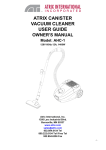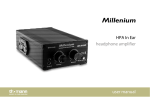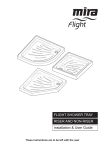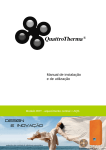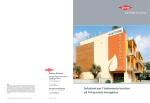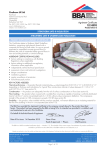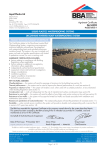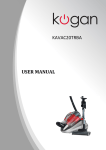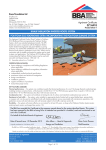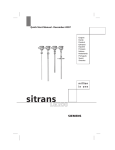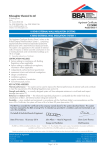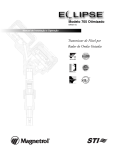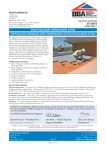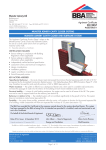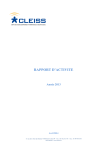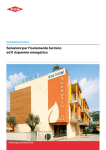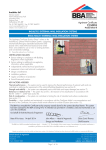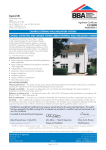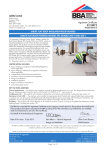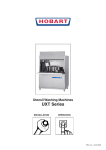Download Dow Chemical Company Limited DOW CHEMICAL ROOF
Transcript
APPROVAL INSPECTION TESTING CERTIFICATION Dow Chemical Company Limited Diamond House Lotus Park Kingsbury Crescent Staines Middlesex TW18 3AG Tel: 01268 798999 TECHNICAL APPROVALS FOR CONSTRUCTION Agrément Certificate 14/5116 Product Sheet 1 e-mail: [email protected] DOW CHEMICAL ROOF INSULATION GREYFOAM SL-A INVERTED ROOF INSULATION This Agrément Certificate Product Sheet (1) relates to Greyfoam SL-A Inverted Roof Insulation, extruded polystyrene boards, for use in the inverted roof concept (above the roof waterproofing) on limited access flat roofs, with either zero pitch, or slopes between 1:80 and 1:6. The product can be used in conjunction with Roofmate MK, a filter/water-control membrane, between the insulation and the ballast layer, forming the Roofmate MinK system, to minimise rainwater flowing underneath the insulation and consequent additional heat loss. (1) Hereinafter referred to as ‘Certificate’. CERTIFICATION INCLUDES: • factors relating to compliance with Building Regulations where applicable • factors relating to additional non-regulatory information where applicable • independently verified technical specification • assessment criteria and technical investigations • design considerations • installation guidance • regular surveillance of production • formal three-yearly review. KEY FACTORS ASSESSED Thermal performance — the product can contribute towards the thermal performance of a roof when installed on typical concrete roof decks. The design thermal conductivity (U) including moisture correction factor, of the product is 0.036 W·m–1·K–1 for board thicknesses ranging from 101 mm to 120 mm and 0.038 W·–1·K–1 for thicknesses >120 mm (see section 6) and 0.037 W·m–1·K–1 for thickness equal to 100 mm. Condensation risk — the product can maintain the deck and roof waterproofing above the dew point and, as part of the MinK system, can reduce the risk of condensation by reducing the amount of rainwater flowing underneath the insulation and cooling the deck (see section 7). Behaviour in relation to fire — when the product is used in the inverted roof concept, the roof may be considered to be of designation EXT.F.AA and therefore satisfies the requirements of the national Building Regulations (see section 8). Resistance to foot traffic — the product, in conjunction with the specified ballast layer, can accept limited foot traffic associated with maintenance operations (see section 9). Durability — the product will have a life of at least 25 years under normal circumstances (see section 13). The BBA has awarded this Certificate to the company named above for the product described herein. This product has been assessed by the BBA as being fit for its intended use provided it is installed, used and maintained as set out in this Certificate. On behalf of the British Board of Agrément Date of First issue: 30 April 2014 John Albon — Head of Approvals Claire Curtis-Thomas Energy and Ventilation Chief Executive The BBA is a UKAS accredited certification body — Number 113. The schedule of the current scope of accreditation for product certification is available in pdf format via the UKAS link on the BBA website at www.bbacerts.co.uk Readers are advised to check the validity and latest issue number of this Agrément Certificate by either referring to the BBA website or contacting the BBA direct. British Board of Agrément Bucknalls Lane Watford Herts WD25 9BA ©2014 Page 1 of 12 tel: 01923 665300 fax: 01923 665301 e-mail: [email protected] website: www.bbacerts.co.uk Regulations In the opinion of the BBA, Greyfoam SL-A Inverted Roof Insulation, if installed, used and maintained in accordance with this Certificate, can contribute to satisfying the relevant requirements of the following Building Regulations (the presence of a UK map indicates that the subject is related to the Building Regulations in the region or regions of the UK depicted): The Building Regulations 2010 (England and Wales) (as amended) Requirement: C2(b) Resistance to moisture Comment: Requirement: L1(a)(i) Conservation of fuel and power Comment: Regulation: 7 Materials and workmanship Comment: Regulation: Regulation: 26 26A CO2 emission rates for new buildings Fabric energy efficiency rates for new dwellings (applicable to England only) The product can contribute to satisfying this Requirement. See sections 7.3 and 7.5 of this Certificate. The product can contribute to satisfying this Requirement. See sections 6.1 and 6.3 of this Certificate. The product is acceptable. See sections 13.1 and 13.2 and the Installation part of this Certificate. The product can contribute to satisfying these Regulations. See sections 6.1 and 6.3 of this Certificate Comment: The Building (Scotland) Regulations 2004 (as amended) Regulation: 8(1) Durability, Workmanship and Fitness of materials Comment: Regulation: Standard: 9 3.15 Building standards applicable to construction Condensation Comment: Standard: Standard: 6.1(b) 6.2 Carbon dioxide emissions Building insulation envelope Comment: Standard: 7.1(a)(b) Statement of sustainability The product is acceptable. See sections 13.1 and 13.2 and the Installation part of this Certificate. The product can contribute to satisfying this Standard. See sections 7.4 and 7.5 of this Certificate. The product can contribute to satisfying these Standards. See sections 6.1 and 6.3 of this Certificate. The product can contribute to satisfying the relevant Requirements of Regulation 9, Standards 1 to 6, and, therefore, will contribute to a construction meeting a bronze level of sustainability as defined in this Standard. In addition, the product can contribute to a construction meeting a higher level of sustainability as defined in this Standard, with reference to clauses 7.1.4(1)(2) [Aspects 1(1)(2) and 2(1)], 7.1.6(1)(2) [Aspects 1(1)(2) and 2(1)] and 7.1.7(1)(2) [Aspect 1(1)(2)]. See section 6.1 of this Certificate. Comment: (1) Technical Handbook (Domestic). (2) Technical Handbook (Non-Domestic). The Building Regulations (Northern Ireland) 2012 Regulation: 23 Fitness of materials and workmanship Comment: Regulation: Regulation: 28(b) 29 Resistance to moisture and weather Condensation Comment: Regulation: Regulation: 39(a)(i) 40(2) Conservation measures Target carbon dioxide emission rate The product is acceptable. See sections 13.1 and 13.2 and the Installation part of this Certificate. The product can contribute to satisfying these Regulations. See section 7.5 of this Certificate. Comment: The product can contribute to satisfying these Regulations. See sections 6.1 and 6.3 of this Certificate. Construction (Design and Management) Regulations 2007 Construction (Design and Management) Regulations (Northern Ireland) 2007 Information in this Certificate may assist the client, CDM co-ordinator, designer and contractors to address their obligations under these Regulations. See sections: 1 Description (1.2 and 1.3), 3 Delivery and site handling (3.4) and 14 Installation (14.2) of this Certificate. Additional Information NHBC Standards 2014 NHBC accepts the use of Greyfoam SL-A Inverted Roof Insulation, when installed and used in accordance with this Certificate, in relation to NHBC Standards, Chapter 7.1 Flat roofs and balconies. CE marking The Certificate holder has taken the responsibility of CE marking the insulation product, in accordance with harmonised European Standard BS EN 13164 : 2012. An asterisk (*) appearing in this Certificate indicates that data shown is given in the manufacturer’s Declaration of Performance. Page 2 of 12 Technical Specification 1 Description 1.1 Greyfoam SL-A Inverted Roof Insulation comprises extruded polystyrene foam boards, rebated for lap jointing (see Figure 1). The product can be used in conjunction with Roofmate MK, a filter/water-control membrane, between the insulation and the ballast layer, forming the Roofmate MinK system, to minimise rainwater flowing underneath the insulation and consequent additional heat loss, for use with a gravel ballast or paving finish Figure 1 Greyfoam SL-A extruded polystyrene foam board A B B A 15 mm 1.25 m ½ thickness ½ thickness section A to A 15 mm 15 mm 0.6 m ½ thickness ½ thickness section B to B 15 mm 1.2 The product has the nominal characteristics shown in Table 1. Table 1 Nominal Characteristics of Greyfoam SL-A Nominal characteristics Minimum density (kg·m ) 33 –3 Compressive strength* (kPa) >300 Work size (mm) 1250 x 600 Overall size (mm) 1265 x 615 Edge detail rebated (all sides) Rebate size (mm) 15 x half board thickness Thicknesses (mm) 100, 120, 140, 160, 180 and 200 Colour pale grey Page 3 of 12 1.3 The Roofmate MinK System comprises Greyfoam SL-A insulation and Roofmate MK, a non-woven polyethylene geotextile, which is used as a filter layer and water control layer between the insulation and the ballast layer. The nominal characteristics of Roofmate MK are shown in Table 2. Table 2 Nominal Characteristics of Roofmate MK Nominal characteristics Length (m) 100 Width (m) 3 Water vapour resistance (MN·s·g ) 0.17 Head of water test (1.0 m) no penetration Weight (g·m ) 60 –1 –2 1.4 A range of accessories, outside the scope of this Certificate, include: • isolating sheet • cushion layer • rainwater outlet grilles • dual-level rainwater outlets • flashings and skirtings • paving ballast • low fines gravel ballast. 2 Manufacture 2.1 Greyfoam SL-A inverted roof insulation boards are manufactured by a continuous extrusion process allowing a skin to form on the surfaces. Boards are then cut to size and rebates formed. 2.2 As part of the assessment and ongoing surveillance of product quality, the BBA has: • agreed with the Certificate holder/manufacturer the quality control procedures and product testing to be undertaken • assessed and agreed the quality control operated over batches of incoming materials • monitored the production process and verified that it is in accordance with the documented process • evaluated the process for management of nonconformities • checked that equipment has been properly tested and calibrated • undertaken to carry out the above measures on a regular basis through a surveillance process, to verify that the specifications and quality control operated by the manufacturer are being maintained. 2.3 The management system of Dow Chemical Company Ltd has been assessed and registered as meeting the requirements of BS EN ISO 9001 : 2008 by BSI Management Systems (Certificate No Q05968). 2.4 Greyfoam SL-A Inverted Roof Insulation is manufactured by Dow Chemical Company Limited for distribution within the UK by Undercover Roofing of Sirdar Road, Brook Industrial Estate, Rayleigh, Essex SS6 7XF. 3 Delivery and site handling 3.1 The product is delivered to site bearing the manufacturer’s name and the BBA logo incorporating the number of this Certificate. 3.2 The product must be protected from prolonged exposure to sunlight by either storage under cover or covering with light-coloured, opaque polythene sheets. 3.3 Care must be taken to prevent contact with solvents and materials containing organic components. 3.4 Where large volumes are stored, especially indoors, flammable material and ignition sources should not be permitted in the vicinity and adequate ventilation (at least two air changes per hour) should be ensured. Assessment and Technical Investigations The following is a summary of the assessment and technical investigations carried out on Greyfoam SL-A Inverted Roof Insulation. Design Considerations 4 General 4.1 Greyfoam SL-A Inverted Roof Insulation is for use as thermal insulation in the inverted roof concept (above the roof waterproofing) on limited access flat or zero pitch roofs of domestic and non-domestic buildings. The system is protected from wind uplift, UV degradation and maintenance foot traffic by paving or a gravel ballast layer. Page 4 of 12 4.2 The insulation product can be covered by the Roofmate MK membrane to form the Roofmate MinK system which acts as a filter layer preventing fines and other debris from passing through. It also acts as a water flow reducing layer, to minimise the flowing of cold rainwater between the insulation and the roof waterproofing with consequent heat loss, and complementary increase in insulation thickness. 4.3 For the purpose of this Certificate: • flat roofs are defined as those roofs having either a finished fall between 1:80 and 1:6, and zero pitch with finished falls from 0 to 1:80. For design purposes on sloping flat roofs, twice the minimum finished fall should be assumed, unless a detailed analysis of the roof is available, including overall and local deflection, direction of falls etc, see also BBA Information Bulletin No 4 • limited access roofs are defined as those roofs subject only to pedestrian traffic for maintenance. 4.4 Concrete, metal or timber roofs should be designed in accordance with relevant provisions of BS 6229 : 2003, BS 8217 : 2005, BS 8218 : 1998, in particular to accommodate the weight of the ballast layer. 4.5 Decks should be covered with one, or more, of the following roof waterproofing specifications: • built-up felt roofing BS 8217 : 2005 using Type 3 and Type 5 felts to BS 8747 : 2007 • mastic asphalt laid in accordance with BS 8218 : 1998 • other waterproofing systems (including reinforced single-ply membranes) which are the subject of a current Agrément Certificate, laid in accordance with, and within the limitations imposed by, that Certificate. 4.6 It is essential that roof falls and drainage paths are correctly designed to avoid ponding and subsequent risk of silt build up, stresses in freezing conditions and to reduce water entry in the event of failure in the waterproofing layer. 4.7 The roof shall be designed with adequate falls unless the roof waterproofing system has been specifically designed and approved for use in a zero pitch roof application. For zero pitch roofs it is particularly important to identify the correct drainage points to ensure that the drainage provided is sufficient and effective. 4.8 Dual level roof drainage should be provided in accordance with BS 6229 : 2003 and BS EN 12056-3 : 2000 to drain water off at the level of the water control layer and at the level of the roof waterproofing. 4.9 Where there is a risk from plasticiser migration or other contaminants from the roof waterproofing, a suitable plastic fibre, or similar isolating sheet, must be interposed between the roof waterproofing and the insulation boards. For loose laid single layer roof waterproofing membranes, a cushion layer should be interposed. 4.10 Sufficient insulation should be provided to maintain the roof waterproofing layer, which acts as a vapour control layer, above the dew point, particularly for lightweight decks. See section 7.2. 4.11 Gravel ballast (rounded low fines of nominal size 16 mm to 32 mm) should be washed and laid to a minimum thickness of 50 mm. Paving ballast should comprise a minimum 40 mm thickness of standard pressed concrete paving slabs to BS EN 1339 : 2003. The imposed dead loads are approximately 80 kg·m–2 and 100 kg·m–2 respectively. 4.12 The ballast layer must be installed to prevent wind uplift (see also section 15.5) and provide complete protection to the boards and Roofmate MK membrane from UV degradation. 4.13 Care must be taken to ensure that upgraded roofs are capable of carrying the increased load and depth of the installed system. 5 Practicability of installation The product can be installed by a competent general builder, or contractor, experienced with this type of product. 6 Thermal performance 6.1 Calculations of thermal transmittance (U value) should be carried out in accordance with BS EN ISO 6946 : 2007, BRE Report BR 443 : 2006 and section 6.2 of this Certificate using the data (design lambda values, U which are the declared lambda D* with addition of moisture correction) given below. Some example U values achieved for the Greyfoam SL-A in conjunction with the membrane and without the Roofmate MK membrane are shown in Tables 3 and 4: 0.037 W·m–1·K–1 (U) for 100 mm thick Greyfoam SL-A boards 0.036 W·m–1·K–1 (U) for thickness from 101 mm to 120 mm thick Greyfoam SL-A boards 0.038 W·m–1·K–1 (U) for >120 mm thick Greyfoam SL-A boards 0.03 drainage factor ‘f’ for MinK system 0.75 drainage factor ‘f’ for Greyfoam SL-A without Roofmate MK membrane. Page 5 of 12 Table 3 Example roof U values (1) — Greyfoam SL-A (without the membrane) U value (W·m–2·K–1) 0.13 0.15 0.18 0.20 0.25 p(3) = 1 2 x 160 140 + 120 — — 160 Insulation thickness(2) (mm) for different rainfalls p(3) = 2 p(3) = 3 2 x 180 160 + 140 2 x 120 — 200 — 180 + 160 140 + 120 2 x 120 — p(3) = 8 — — — — 140 + 120 (1) Deck taken as 200 mm dense reinforced concrete, ( = 2.5 W·m–1·K–1). (2) Thinnest available thickness, or thickness combination, to achieve the design U value. (3) p = mm/day. NOTE: fx = 0.03 W·day·m–2·K–1·mm–1. Table 4 Example roof U values (1) — with Roofmate MinK system (with the membrane) U value (W·m–2·K–1) 0.10 0.13 0.15 0.18 0.20 0.25 Insulation thickness(2) (mm) for different rainfalls p (3) = 1 p (3) = 2 p (3) = 3 p (3) = 8 2 x 180 2 x 140 2 x 120 200 180 160 2 x 180 2 x 140 2 x 120 200 180 160 2 x 180 2 x 140 2 x 120 200 180 160 200 + 180 2 x 140 2 x 120 — — 160 (1) Deck taken as 200 mm dense reinforced concrete, ( = 2.5 W·m–1·K–1). (2) Thinnest available thickness, or thickness combination, to achieve the design U value. (3) p = mm/day. NOTE: fx = 0.001 W·day·m–2·K–1·mm–1. 6.2 Cold rainwater reaching the roof waterproofing membrane will temporarily affect the rate of heat loss from the roof and should be accounted for by adding a correction (⌬Ur) to the calculated roof U value in accordance with section 7 and Annex D.4 of BS EN ISO 6946 : 2007, as follows: ⌬Ur = p·f·x (R1/RT)2 where: ⌬Ur correction to the calculated thermal transmittance of the roof element (W·m–2·K–1). p average rate of precipitation during the heating season (mm·day–1)(1). f drainage factor giving the fraction of p reaching the waterproof membrane. x factor for increased heat loss caused by rainwater flowing on the membrane = 0.04 W·day·m–2·K–1·mm–1. R1 thermal resistance of the layer of the insulation above the waterproofing membrane (m2·K·W–1). RT total thermal resistance of the construction before application of the correction (m2·K·W–1). (1) Monthly and seasonal average rainfall for different UK locations (1981 to 2010) can be found at http://www.metoffice.gov.uk/climate/uk/averages/ukmapavge.html and divided by the number of days to obtain p in mm·day–1. 6.3 The product can contribute to maintaining continuity of thermal insulation at junctions. For Accredited Construction Details the corresponding psi values in BRE Information Paper IP 1/06, Table 3 may be used in carbon emission calculations in Scotland and Northern Ireland. Detailed guidance for other junctions and on limiting heat loss by air infiltration can be found in: England and Wales — Approved Documents to Part L and for new thermal elements to existing buildings, Accredited Construction Details (version 1.0). See also SAP 2009 Appendix K and the iSBEM User Manual for new-build Scotland — Accredited Construction Details (Scotland) Northern Ireland — Accredited Construction Details (version 1.0). 7 Condensation risk 7.1 The inverted roof concept maintains the roof waterproofing close to the building’s internal temperature and consequently presents a low risk of interstitial or surface condensation. 7.2 The Roofmate MK membrane will substantially limit the flow of cold rainwater between the boards and the roof waterproofing. The duration and extent of deck cooling and consequent risk of interstitial or surface condensation will therefore be negligible with concrete decks. However, care should be taken with lightweight decks (R <0.15 m2·K·W–1) and when upgrading existing roof structures, particularly if they contain existing insulation. Where the Roofmate Page 6 of 12 MK membrane is not used the risk of interstitial condensation due to deck cooling may be assessed by reducing the proposed thickness of Greyfoam SL-A insulation by 20%, for the purposes of the risk calculation, to BS 5250 : 2011 Annexes D and H.9 and BS EN ISO 10456 : 2007. 7.3 Roofs will adequately limit the risk of surface condensation when the thermal transmittance (U value) does not exceed 0.35 W·m–2·K–1 at any point and the junctions with other elements are designed in accordance with Limiting thermal bridging and air leakage : Robust construction details for dwellings and similar buildings (TSO 2002), BRE Information Paper IP 1/06 or section 6.3 of this Certificate. 7.4 Roofs will adequately limit the risk of surface condensation when the thermal transmittance (U value) does not exceed 1.2 W·m–2·K–1 at any point and the roof complies with Annex H of BS 5250 : 2011. Further guidance may be obtained from BRE Report BR 262 : 2002. Interstitial condensation 7.5 Roofs will adequately limit the risk of interstitial condensation when they are designed and constructed in accordance with BS 5250 : 2011, Annexes D and H. 8 Behaviour in relation to fire 8.1 When fully supporting one of the following ballast layers, the roof may be considered to be of designation EXT.F.AA (low vulnerability in Scotland) and therefore adequately resist fire spread over the roof and from adjacent buildings: • minimum 50 mm deep layer of washed rounded gravel of nominal size 16 mm to 32 mm • minimum 40 mm thick standard pressed concrete paving slabs to BS EN 1339 : 2003. 8.2 The designation of other specifications should be confirmed by test or assessment. 8.3 The product should not be laid over compartment walls. 9 Resistance to foot traffic When covered with a ballast layer, as specified in section 4, the product can accept the limited foot traffic and light concentrated loads associated with installation and maintenance operations. 10 Resistance to plant growth and insects 10.1 The product, when covered with one of the protection systems described in the Installation section, will not normally support the growth of plants. However, where there is run-off from a large sill or gully onto the surface of the roof, excessive build-up of silt may provide conditions for germination of seeds. Therefore this type of detail should be avoided. Growth that may occur will be restricted, will not normally affect the performance of the roof, and will be no worse than that which may occur on traditional flat roofs. 10.2 Although small insects may be found under the product, they will neither attack nor have any effect on the performance or durability of the boards. 11 Effect on roof waterproofing 11.1 The inverted roof concept will provide solar protection and also limit the range of temperatures to which the waterproofing membrane will be subjected. Placing the insulation on top of the roof waterproofing will normally lead to an extended life of the waterproofing layer. 11.2 Separation or cushion layers between the boards and the roof waterproofing may be needed in some circumstances (see section 4.7 of this Certificate). 12 Maintenance 12.1 The inverted roof concept requires little or no maintenance, other than annual removal of any plants, and cleaning of water outlets and gutters if necessary. Gravel loading, if used, should be checked for displacement, and that it is not blocking a gully or exposing the boards or the Roofmate MK membrane to UV degradation. If necessary, further guidance on cleaning and maintenance is available from the Certificate holder. 12.2 Should a leak occur in the roof waterproofing it must be repaired following removal of the gravel ballast layer, water control layer and insulation boards. Correct reinstatement of these layers must be carried out with particular care and the advice of the Certificate holder should be sought. 13 Durability 13.1 The product is not significantly affected by freeze/thaw cycles and water. 13.2 The inverted roof will have a life of at least 25 years, under normal circumstances. 13.3 Care must be taken to ensure that the gravel ballast layer, once installed, provides complete cover to the boards or the Roofmate MK membrane at all times to avoid the risk of UV degradation. Page 7 of 12 Installation 14 General 14.1 Greyfoam SL-A Inverted Roof Insulation should be installed in accordance with the relevant guidance in section 4 of this Certificate, providing adequate load bearing capacity, falls, drainage, sound roof waterproofing and limited risk of condensation. 14.2 The insulation product is laid in accordance with the Certificate holder’s instructions. The product is light and may be installed in any weather but, due to their size, care will be needed in high winds. Installers must not carry them near to parapets or apertures in the deck and, once placed, they must be restrained immediately. 14.3 It is essential that all joints between the boards are tight and no gaps exist where they meet rooflights, edge details and other services which perforate the roof deck. The product can be cut easily using for example a handsaw or knife. 14.4 Roofmate MK membrane should be loose laid over the insulation, at right angles to the slope with 300 mm deep weathered laps running down the slope. At upstands and penetrations Roofmate MK membrane should be turned up to finish above the surface of the ballast layer and turned down at drainage outlets. 14.5 The loading layer should be installed in accordance with BS 6399-2 : 1997 and BRE Digest 295 : 1985 and BRE Digest 311 : 1986. 14.6 The ballast loading layer must be applied as work progresses to protect the insulation and the filter/water-control layer from the effects of wind uplift and solar degradation. The ballast must not be stacked in one place on the roof unless the roof is strong enough to support it. Upgrading roofs 14.7 In existing roofs (see Figure 6 in section 15.7), all the requirements of sections 14.1 to 14.6 apply and, in addition, the existing roofing and substructure must be examined for degradation and, where necessary, repairs effected. Particular consideration should be given to the condensation risk that the existing roof structure may present. See section 7 of this Certificate. 14.8 Where, for example, parapets, details and services have insufficient height to accommodate the increased depth of insulation/protection, due provisions need to be made (ie a minimum of 150 mm from the top of the gravel to the top of the skirtings). If upgrading involves laying the product on existing inverted roof insulation, the advice of the Certificate holder should be sought. 14.9 Rainwater outlets will need to be modified or replaced to suit, eg by the installation of gravel guards. 15 Procedure 15.1 Typical new construction details are given in Figures 2, 3, 4 and 5. Figure 2 Typical installation detail — gravel/paving finish ballast paving slabs on spacer pads Roofmate MK Greyfoam SL-A Inverted Roof Insulation waterproof layer concrete slab Page 8 of 12 Figure 3 Water outlet detail — gravel finish rainwater outlet ballast Roofmate MK Greyfoam SL-A Inverted Roof Insulation waterproof layer screed to falls concrete slab Figure 4 Water outlet detail — paving slab finish paving slabs on spacer pads Roofmate MK Greyfoam SL-A Inverted Roof Insulation waterproof layer screed to falls concrete slab rainwater outlet Page 9 of 12 Figure 5 Parapet upstand detail — gravel finish apron flashing Roofmate LG ballast Roofmate MK Greyfoam SL-A Inverted Roof Insulation waterproof layer concrete slab 15.2 It is essential to establish that the roof waterproofing has been installed correctly and that it is weathertight. Every joint between sheets, flashing and other details must be checked to ensure that the roof covering is suitable for an inverted roof specification. 15.3 Single-layer roofing must be the subject of very close scrutiny, and the inspection must include an examination for perforation and for the likelihood of subsequent perforation from beneath by, for example, uneven decks and protruding nail heads. When a single-layer, polymeric loose-laid waterproofing membrane is used, a cushion layer should be interposed between it and the roof deck. 15.4 The roof waterproofing must be clean and free from any extraneous matter. 15.5 When the product is to be placed over a loose-laid roof covering, it should be installed and ballasted as soon as possible to protect the covering from the effects of wind uplift. See also sections 4.11 and 4.12 of this Certificate. 15.6 Installers of the product must take care not to damage the roof waterproofing, particularly in the case of thin single-layer materials which may be easily damaged. 15.7 The product and Roofmate MK membrane are laid in accordance with the Certificate holder’s instructions and sections 14.2 to 14.4 of this Certificate. Figure 6 Greyfoam SL-A used to upgrade existing insulation gravel 16 - 32 mm (nominal size) Roofmate MK Greyfoam SL-A Inverted Roof Insulation waterproofing membrane old insulation deck Page 10 of 12 15.8 The gravel loading specification is used on roofs in sheltered regions or low to medium rise buildings up to 10 storeys (25 m) with a single row of paving laid around the roof periphery. When laid in moderate exposure zones, or on buildings of up to 15 storeys (37.5 m) the width of paving should be determined by reference to BS 6399-2 : 1997 and BRE Digest 295 : 1985. Where there is a risk of wind scour and/or possible dislodgement of the ballast, BRE Digest 311 : 1986 should be consulted. Technical Investigations 16 Tests An examination was made of the results of test data in respect of BS EN 13164 : 2008 Section 4.2 and relevant parts of section 4.3 and the ETAG 031 : 2010 and the drainage factor ‘f’ for a test roof incorporating the Roofmate MK membrane for both flat roof and zero pitch conditions. 17 Investigations 17.1 Assessments were made in respect of: • production quality control (Greyfoam SL-A) • practicability of installation • example roof U values • risk of condensation • resistance to wind uplift. 17.2 The manufacturing process was evaluated, including methods of quality control. Details were also obtained of the quality and composition of the materials used. Additional Information Dow Chemical Company Limited has declared the designation of this product to be XPS-EN13164-T1-DLT(2)5-CS(10/Y) 300-CC(2/1.5/50)130-WD(V)1-WL(T)0.7-FTCD1-DS(70,90), in accordance with Section 6 of BS EN 13164 : 2012. Bibliography BS 5250 : 2011 Code of practice for control of condensation in buildings BS 6229 : 2003 Flat roofs with continuously supported coverings — Code of practice BS 6399-2 : 1997 Loading for buildings — Code of practice for wind loads BS 8217 : 2005 Reinforced bitumen membranes for roofing — Code of practice BS 8218 : 1998 Code of practice for mastic asphalt roofing BS 8747 : 2007 Reinforced bitumen membranes (RBMs) for roofing — Guide to selection and specification BS EN 1339 : 2003 Concrete paving flags — Requirements and test methods BS EN 12056-3 : 2000 Gravity Drainage Systems inside Buildings — Roof drainage, layout and calculation BS EN 13164 : 2008 Thermal insulation products for buildings — Factory made products of extruded polystyrene foam (XPS) — Specification BS EN 13164 : 2012 Thermal insulation products for buildings — Factory made extruded polystyrene foam (XPS) products — Specification BS EN ISO 6946 : 2007 Building components and building elements — Thermal resistance and thermal transmittance — Calculation method BS EN ISO 9001 : 2008 Quality management systems — Requirements BS EN ISO 10456 : 2007 Building materials and products — Hygrothermal properties — Tabulated design values and procedures for determining declared and design thermal values BBA Information Bulletin No 4 Inverted roofs — Drainage and U value corrections BRE Digest 295 : 1985 Stability under wind load of loose laid external roof insulation boards BRE Digest 311 : 1986 Wind scour of gravel ballast on roofs BRE Information Paper IP 1/06 Assessing the effects of thermal bridging at junctions and around openings BRE Report (BR 262 : 2002) Thermal insulation : Avoiding risks BRE Report (BR 443 : 2006) Conventions for U-value calculations ETAG 031 : 2010 Guideline for European Technical Approval of Inverted Roof Insulation Kits — Part 1 General Page 11 of 12 Conditions of Certification 18 Conditions 18.1 This Certificate: • relates only to the product/system that is named and described on the front page • is issued only to the company, firm, organisation or person named on the front page — no other company, firm, organisation or person may hold or claim that this Certificate has been issued to them • is valid only within the UK • has to be read, considered and used as a whole document — it may be misleading and will be incomplete to be selective • is copyright of the BBA • is subject to English Law. 18.2 Publications, documents, specifications, legislation, regulations, standards and the like referenced in this Certificate are those that were current and/or deemed relevant by the BBA at the date of issue or reissue of this Certificate. 18.3 This Certificate will remain valid for an unlimited period provided that the product/system and its manufacture and/or fabrication, including all related and relevant parts and processes thereof: • are maintained at or above the levels which have been assessed and found to be satisfactory by the BBA • continue to be checked as and when deemed appropriate by the BBA under arrangements that it will determine • are reviewed by the BBA as and when it considers appropriate. 18.4 The BBA has used due skill, care and diligence in preparing this Certificate, but no warranty is provided. 18.5 In issuing this Certificate, the BBA is not responsible and is excluded from any liability to any company, firm, organisation or person, for any matters arising directly or indirectly from: • the presence or absence of any patent, intellectual property or similar rights subsisting in the product/system or any other product/system • the right of the Certificate holder to manufacture, supply, install, maintain or market the product/system • actual installations of the product/system, including their nature, design, methods, performance, workmanship and maintenance • any works and constructions in which the product/system is installed, including their nature, design, methods, performance, workmanship and maintenance • any loss or damage, including personal injury, howsoever caused by the product/system, including its manufacture, supply, installation, use, maintenance and removal • any claims by the manufacturer relating to CE marking. 18.6 Any information relating to the manufacture, supply, installation, use, maintenance and removal of this product/ system which is contained or referred to in this Certificate is the minimum required to be met when the product/system is manufactured, supplied, installed, used, maintained and removed. It does not purport in any way to restate the requirements of the Health and Safety at Work etc. Act 1974, or of any other statutory, common law or other duty which may exist at the date of issue or reissue of this Certificate; nor is conformity with such information to be taken as satisfying the requirements of the 1974 Act or of any statutory, common law or other duty of care. British Board of Agrément Bucknalls Lane Watford Herts WD25 9BA ©2014 Page 12 of 12 tel: 01923 665300 fax: 01923 665301 e-mail: [email protected] website: www.bbacerts.co.uk












